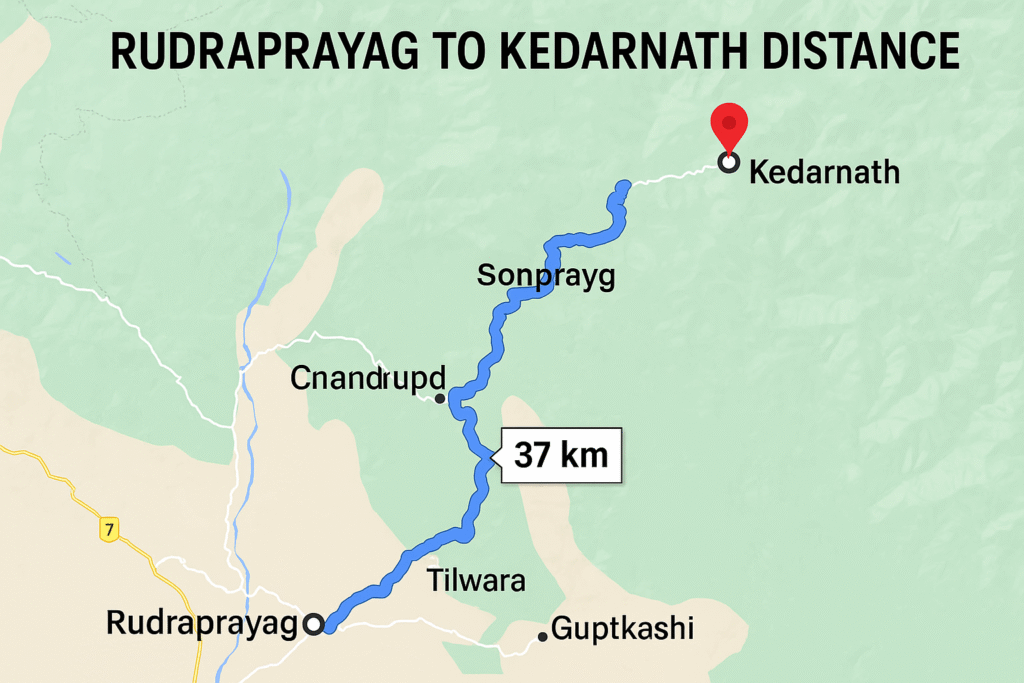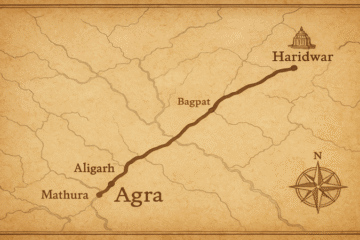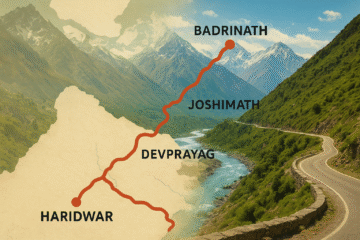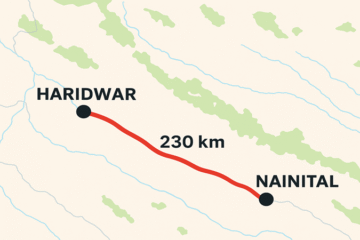
Table of Contents
The journey to Kedarnath, one of the holiest shrines in Hinduism, is a pilgrimage that transcends mere travel; it is an odyssey into the heart of faith, amidst the breathtaking grandeur of the Himalayas. For countless devotees, the path often begins or passes through Rudraprayag, a town steeped in spiritual significance. Understanding the Rudraprayag to Kedarnath distance is crucial for anyone planning this sacred expedition, as it involves a combination of road travel and a challenging, yet profoundly rewarding, trek. This comprehensive guide will navigate you through every segment of this divine route, offering insights into the journey, the spiritual significance, and practical advice for a safe and memorable pilgrimage.
Rudraprayag: The Sacred Confluence
Nestled in the Garhwal region of Uttarakhand, Rudraprayag holds a pivotal position in the Char Dham Yatra circuit. It is one of the Panch Prayag, the five sacred confluences of the Alaknanda River, where the mighty Alaknanda meets the revered Mandakini River. This confluence is considered highly auspicious, believed to purify the soul and grant spiritual merit. The town derives its name from Lord Shiva, who is said to have appeared here in his Rudra avatar to bless Narada Muni.
Rudraprayag serves as a crucial transit point due to its strategic location. From here, one route leads towards Badrinath, while the other branches off towards Kedarnath. The town itself offers a serene environment for pilgrims to rest and acclimatize. Notable attractions include the ancient Rudranath Temple at the confluence, the Koteshwar Mahadev Temple (a cave temple dedicated to Lord Shiva), and the Kartik Swami Temple, which requires a short trek but offers panoramic views of the Himalayan peaks. The spiritual aura of Rudraprayag prepares pilgrims for the more arduous journey ahead, making it an essential stop before embarking on the final leg to Kedarnath.
The Road Journey: Rudraprayag to Gaurikund
The first major segment of the Rudraprayag to Kedarnath distance involves a picturesque road journey from Rudraprayag to Gaurikund. The approximate Rudraprayag to Gaurikund distance is around 72 to 79 kilometers, and it typically takes about 3 to 4 hours by road, depending on traffic and road conditions.
The route from Rudraprayag largely follows National Highway 107 (NH107), winding through the scenic Mandakini valley. Pilgrims will pass through several small towns and villages, each offering a glimpse into the local Garhwali culture and stunning Himalayan vistas. Key towns along this stretch include Tilwara, Agastyamuni (known for the temple dedicated to Sage Agastya), Kund, Guptkashi, Phata, and Sonprayag.
Guptkashi is a significant stop, often serving as an overnight halt for pilgrims. It is home to the ancient Vishwanath Temple and Ardhanarishwar Temple, and its spiritual ambiance mirrors that of Varanasi (Kashi), hence its name “Hidden Kashi.” Phata is another important point, especially for those considering helicopter services to Kedarnath, as it hosts several helipads.
The motorable road extends up to Sonprayag. From Sonprayag, heavy vehicles are usually not allowed, and pilgrims must take local shared jeeps or taxis for the final 5 to 6 kilometers to Gaurikund. This short shuttle ride is a common practice to manage traffic and ensure pilgrim safety, especially during peak season. The road conditions in this mountainous region can be challenging, particularly during the monsoon season (July to September), when landslides are common. It is advisable to check weather forecasts and road advisories before commencing the journey. Various transportation options are available, including private taxis, shared jeeps, and state-run buses, offering flexibility for different budgets and preferences.
The Holy Trek: Gaurikund to Kedarnath
Upon reaching Gaurikund, the motorable journey ends, and the true test of faith and endurance begins: the sacred trek to Kedarnath. The Gaurikund to Kedarnath distance is approximately 16 kilometers, a challenging uphill climb that takes pilgrims through diverse terrains and offers unparalleled views of the Himalayan landscape.
Gaurikund itself is a revered spot, named after Goddess Parvati (Gauri), who is believed to have performed penance here to win Lord Shiva. It is famous for its hot water springs, where pilgrims traditionally take a purifying dip before starting the arduous trek.
The trek route is well-defined and maintained, though it demands significant physical fitness due to the continuous ascent and the high altitude. The altitude gain from Gaurikund (around 1,982 meters or 6,500 feet) to Kedarnath (3,583 meters or 11,755 feet) is substantial, approximately 5,072 feet, which can lead to altitude sickness if proper acclimatization is not observed.
The 16-kilometer trek typically takes between 4 to 8 hours for an average walker, depending on their pace, fitness level, and the number of stops taken. The path winds through lush green valleys, alongside the Mandakini River, and past waterfalls and small hamlets. Key points along the trekking route include Jungle Chatti (approx. 4 km from Gaurikund), Bhimbali (approx. 3 km from Jungle Chatti), Lincholi (approx. 4 km from Bhimbali), and finally, Kedarnath (approx. 4 km from Lincholi). There are several tea stalls, small eateries, and rest points along the way, providing refreshments and shelter.
For those unable to undertake the trek on foot, various alternative options are available from Gaurikund or Sonprayag. Pilgrims can hire ponies or mules, which are a popular choice, or opt for a Doli/Palki (palanquin) carried by porters. Helicopter services are also available from nearby helipads like Phata, Guptkashi, and Sersi, offering a quicker and less strenuous way to reach Kedarnath, though these are subject to weather conditions and advance booking.
Physical preparation is paramount for this trek. It is advisable to engage in regular exercise, such as brisk walking, jogging, and breathing exercises, for at least a few weeks before the journey to build stamina and improve lung capacity. Acclimatization at Gaurikund or Sonprayag for a day is highly recommended to allow the body to adjust to the higher altitude, minimizing the risk of Acute Mountain Sickness (AMS).
Kedarnath Dham: The Abode of Lord Shiva
After the challenging yet spiritually enriching journey, pilgrims arrive at Kedarnath, the sacred abode of Lord Shiva. Situated at an elevation of 3,583 meters (11,755 feet) amidst the majestic Garhwal Himalayas, the Kedarnath Temple is one of the twelve Jyotirlingas, considered the most sacred shrines of Lord Shiva. The temple, believed to have been built by the Pandavas and later revived by Adi Shankaracharya in the 8th century, stands as a testament to ancient Indian architecture and unwavering faith.
The temple’s imposing stone structure, set against the backdrop of snow-capped peaks and the roaring Mandakini River, creates an awe-inspiring spectacle. The atmosphere is charged with devotion, with chants of “Om Namah Shivaya” echoing through the valley. Due to extreme weather conditions, the Kedarnath Temple remains open only for about six months a year, typically from late April/early May to October/November, depending on the auspicious dates of Akshaya Tritiya and Bhai Dooj. During the winter months, the idol of Lord Kedarnath is moved to Ukhimath for worship.
Beyond the main temple, several other significant sites can be visited in Kedarnath:
-
Shankaracharya Samadhi: Located behind the Kedarnath Temple, this is the sacred resting place of Adi Shankaracharya, the great philosopher and saint who consolidated the Advaita Vedanta doctrine and established the four holy Dhams.
-
Bhairavnath Temple: Situated on a hill approximately 800 meters from the main temple, this temple is dedicated to Lord Bhairav, believed to be the protector of Kedarnath Dham during the winter months when the main temple is closed.
-
Vasuki Tal: A beautiful glacial lake located about 8 kilometers from Kedarnath, offering stunning views of the Chaukhamba peaks. The trek to Vasuki Tal is challenging but rewarding for nature lovers.
-
Chorabari Tal (Gandhi Sarovar): Another pristine glacial lake, about 4 kilometers from Kedarnath, where Mahatma Gandhi’s ashes were immersed.
-
Rudra Meditation Cave: A small, modern cave near the temple complex that gained popularity after Prime Minister Narendra Modi meditated there. It offers a serene spot for quiet contemplation.
The sheer natural beauty, combined with the profound spiritual energy, makes Kedarnath an unforgettable destination for pilgrims and adventurers alike.
Planning Your Kedarnath Yatra
A well-planned journey is essential for a safe and fulfilling Kedarnath Yatra, especially considering the varied Rudraprayag to Kedarnath distance and the challenging terrain.
Best Time to Visit: The ideal time to undertake the Kedarnath Yatra is during the summer months (May to June) and the post-monsoon autumn period (September to October).
-
April to June: The weather is generally pleasant, with temperatures ranging from 10°C to 15°C. This is the peak season, offering clear skies and comfortable trekking conditions.
-
July to August: This is the monsoon season, characterized by heavy rainfall, landslides, and slippery trails. Travel during these months is highly discouraged due to safety risks.
-
September to October: The monsoon recedes, leaving behind lush green landscapes and crisp, clear weather. Temperatures range from 4°C to 11°C. This is an excellent time to visit as the crowds are thinner than in peak summer, and the views are spectacular.
-
November to March: The temple remains closed due to heavy snowfall and extremely cold temperatures (often below freezing, ranging from 0°C to -18°C).
Accommodation: Accommodation options are available at various points along the route.
-
Rudraprayag, Guptkashi, Sonprayag: These towns offer a range of hotels, guesthouses, and dharamshalas catering to different budgets. It’s advisable to book in advance, especially during peak season.
-
Gaurikund: Basic guesthouses and lodges are available.
-
Kedarnath: Accommodation near the temple is primarily in GMVN (Garhwal Mandal Vikas Nigam) camps, pre-fabricated huts, and a few private guesthouses/dharamshalas. These are basic but provide essential amenities. Booking well in advance is crucial due to limited availability.
Registration: Mandatory registration for the Char Dham Yatra, including Kedarnath, is required by the Uttarakhand government. Pilgrims must carry their registration slip and a valid ID (like an Aadhaar card) at all times for verification. This can often be done online or at designated registration counters.
Health and Safety Tips:
-
Medical Check-up: Consult a doctor before the trip, especially if you have pre-existing medical conditions (heart disease, asthma, diabetes). Children under 12 and seniors over 60 are often advised to avoid the trek due to low oxygen levels.
-
Physical Preparation: Begin physical training (brisk walking, jogging, stair climbing, breathing exercises) 4-6 weeks prior to the trek.
-
Acclimatization: Spend a day or two at a lower altitude (e.g., Rudraprayag, Guptkashi, Sonprayag) to acclimatize.
-
Hydration: Drink plenty of water and fluids throughout the journey to prevent dehydration and altitude sickness. Carry a reusable water bottle.
-
Layered Clothing: Pack warm, layered clothing, including thermal wear, woolens, a heavy jacket, gloves, and caps, as temperatures can drop suddenly. Rain gear (waterproof jacket and pants) is also essential.
-
Footwear: Wear sturdy, comfortable, waterproof trekking shoes with good grip.
-
Essentials: Carry a well-stocked first-aid kit with personal medications, pain relievers, antiseptics, bandages, and basic altitude sickness medication. A portable oxygen canister can be useful. Also carry a power bank, cash in small denominations (ATMs are scarce), and a torch.
-
Food: Carry energy bars, dry fruits, and light snacks. Avoid heavy meals before and during the trek.
-
Pace Yourself: Trek slowly, take frequent breaks, and avoid overexertion. Listen to your body and descend if you experience symptoms of AMS (headache, nausea, dizziness, shortness of breath).
-
Stay Informed: Check daily weather forecasts and road conditions. Avoid trekking during heavy rain or snow.
-
Respect Customs: Follow local customs and traditions. Avoid littering and maintain the sanctity of the pilgrimage route.
Conclusion
The Rudraprayag to Kedarnath distance represents more than just kilometers; it signifies a profound spiritual journey through the awe-inspiring Himalayas. From the sacred confluence at Rudraprayag to the challenging yet exhilarating trek from Gaurikund, every step on this path is imbued with devotion and natural beauty. While the journey demands physical preparedness and careful planning, the reward of reaching the ancient Kedarnath Temple, nestled amidst snow-clad peaks, is an experience that touches the soul. By understanding the route, preparing adequately, and embracing the spiritual essence of the pilgrimage, devotees can ensure a safe, memorable, and truly transformative yatra to the abode of Lord Shiva.
Frequently Asked Questions (FAQs)
1. What is the total Rudraprayag to Kedarnath distance?
Ans. The total Rudraprayag to Kedarnath distance is approximately 95 kilometers. This includes a road journey of about 72-79 kilometers from Rudraprayag to Gaurikund (with a short shuttle ride from Sonprayag to Gaurikund) and a 16-kilometer trek from Gaurikund to Kedarnath.
2. How far is Rudraprayag from Gaurikund by road, and how long does it take?
Ans. The road distance from Rudraprayag to Gaurikund is approximately 72 to 79 kilometers. The journey typically takes about 3 to 4 hours by road, depending on traffic and road conditions. From Sonprayag, a short 5-6 km shuttle ride to Gaurikund is required.
3. What is the trekking distance from Gaurikund to Kedarnath, and how long does it take?
Ans. The trekking distance from Gaurikund to Kedarnath is 16 kilometers. This challenging uphill trek usually takes between 4 to 8 hours for an average walker, depending on their pace and fitness level.
4. What is the best time to visit Kedarnath?
Ans. The ideal time to visit Kedarnath is during the summer months (May to June) and the post-monsoon autumn period (September to October). The temple remains closed from November to March due to heavy snowfall. Travel during the monsoon season (July to August) is highly discouraged due to risks of landslides.
5. Are there alternative transport options for the trek to Kedarnath?
Ans. Yes, for those unable to trek on foot, alternative options are available from Gaurikund or Sonprayag. Pilgrims can hire ponies or mules, or opt for a Doli/Palki (palanquin) carried by porters. Helicopter services are also available from nearby helipads like Phata, Guptkashi, and Sersi.
6. Is registration mandatory for the Kedarnath Yatra?
Ans. Yes, mandatory registration for the Char Dham Yatra, including Kedarnath, is required by the Uttarakhand government. Pilgrims must carry their registration slip and a valid ID (like an Aadhaar card) at all times for verification.
7. What kind of accommodation is available along the Kedarnath route and at Kedarnath?
Ans. Rudraprayag, Guptkashi, and Sonprayag offer a range of hotels, guesthouses, and dharamshalas. At Gaurikund, basic guesthouses and lodges are available. In Kedarnath, accommodation near the temple is primarily in GMVN camps, pre-fabricated huts, and a few private guesthouses/dharamshalas, which are basic but provide essential amenities.
8. What health and safety tips should I follow for the Kedarnath Yatra?
Ans. It is crucial to consult a doctor before the trip, especially if you have pre-existing medical conditions. Begin physical training weeks in advance, acclimatize at lower altitudes, stay well-hydrated, and pack warm, layered clothing and sturdy trekking shoes. Carry a first-aid kit and avoid overexertion.
9. What is the significance of Rudraprayag?
Ans. Rudraprayag is one of the Panch Prayag (five sacred confluences) of the Alaknanda River, where it meets the Mandakini River. It is considered highly auspicious and is named after Lord Shiva’s Rudra avatar. It serves as a crucial transit point for pilgrims heading to both Kedarnath and Badrinath.
10. What are some other significant places to visit near Kedarnath Temple?
Ans. Besides the main temple, you can visit Shankaracharya Samadhi (resting place of Adi Shankaracharya), Bhairavnath Temple (protector deity), Vasuki Tal (a glacial lake), Chorabari Tal (Gandhi Sarovar), and the Rudra Meditation Cave.


